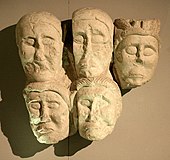Granet Museum
The Musée Granet is an art museum in Aix-en-Provence , one of the oldest and richest in France .
history
The museum was founded in 1765. The foundation of the collection of antiquities from Fauris de Saint-Vincent . Since the 19th century, the museum has been housed in a priory of the Order of Malta , which was built in 1671 on the site of the Saint-Jean-de-Malte church in the Mazarin district . The inauguration took place in 1838 under the name Musée d'Aix .
In 1849, the collection of antiquities was supplemented by bequests from the painter François Marius Granet (1775–1849), a friend of Jean-Auguste-Dominique Ingres , who bequeathed all the works of art in his possession to his native town of Aix. According to his will, 200 works were given to the Louvre . The collection was supplemented by several foundations: Jean-Baptiste de Bourguignon de Fabregoules, for example, bequeathed 800 works of art to the museum.
The Granet wing was built from 1860 onwards. A second building followed in 1870, a third in 1900 and the complex was completed around 1940.
In 1949 the museum was renamed on the 100th anniversary of Granet's death and has been named after him ever since.
In 1984, eight exemplary pictures by Cézanne reached the Musée Granet as permanent loans from Paris . Until then, the city could not have a single painting by this important artist from Aix.
Important contemporary works of art come from an anonymous foundation from 2000, which are exhibited under the name De Cézanne à Giacometti .
All buildings were thoroughly renovated from 1990 to 2005. In 2006 the museum received a renovation costing 21 million euros and was able to reopen after extensive renovation work.
The temporary exhibition Picasso - Cézanne was on view at the Musée Granet until September 27, 2009.
Museum collections
archeology
In the entrance hall, the museum houses an archaeological collection that shows artefacts from Roman times and Celto-Ligurian finds from the Oppidum Entremont . Torsos of statues of young men and the famous head sculptures ( têtes coupées ) are exhibited. These are replicas of severed heads that the Celts took from their slain opponents and hung up as trophies at the entrances to their sanctuaries. A block in the museum shows five such heads placed next to and on top of each other. In addition, some Roman portraits , sarcophagi and grave steles are on display.
Visual arts
Paintings are shown on the upper floor, most of which come from the collection of the patron and painter François Marius Granet. You can see romantic landscape scenes from Italy as well as small landscape sketches in oil and watercolor that were influenced by Corot . The main work Jupiter and Thetis by Jean-Auguste-Dominique Ingres (1780–1867) is exhibited, as is a portrait of Granet, whom he met during his training years in Paris. Other works in the Musée Granet are by great French painters such as Henri Matisse and Fernand Léger .
Of the Dutch painters, Peter Paul Rubens (1577–1640) and Robert Campin (1375–1444) and the “ Master of Flémalle ” are represented. His work shows a group of three with Peter , Augustine and a donor, above whom a Madonna hovers enthroned . There are also many smaller works and depictions of a festive feast from the 16th century ( School of Fontainebleau ).
The main exhibits in the museum are the works of local artist Paul Cézanne, who was born in Aix-en-Provence in 1839. The pictures came on permanent loan from Paris to the Musée Granet. These are small-format oil paintings that cover the entire artistic career of the painter. However, there is none in the collection that shows the famous motif of Mont Sainte-Victoire . The earliest work of the eight pictures is "The Kiss of the Muses", which Cézanne copied from the painter Félix Nicolas Frillie (1821–1863) at the age of twenty . The other paintings include landscapes, still lifes , nudes and portraits, but also late works that can be attributed to Cubism .
See also
literature
- Denis Coutagne, et al .: Le Musée Granet, Aix-en-Provence. Réunion des musées nationaux, Paris 2007, ISBN 2-7118-5292-X .
- Thorsten Droste: Provence: ancient arenas, Romanesque cloisters, cities with history - a journey through France's sunny province. 7th edition. Reiseverlag Dumont, Ostfildern 2011, ISBN 978-3-7701-3927-9 , pp. 242–244.
- Ines Mache, Stefan Brandenburg: Provence. 7th revised and completely updated edition. Reise Know-How Verlag Rump, Bielefeld 2011, ISBN 978-3-8317-2022-4 , p. 443.
- Cony Ziegler: Provence with Camargue. Travel book publisher Iwanowski. 2nd updated edition. Dormagen 2009, ISBN 978-3-933041-54-8 , p. 441.
Web links
Individual evidence
- ↑ a b Mache, Brandenburg: Provence. P. 443.
- ↑ a b c d e f Droste: Provence. P. 242.
- ^ Musée Granet, Aix-en-Provence . Réunion des musées nationaux, 2007.
- ^ Ziegler: Provence with Camargue. P. 441.
- ^ Droste: Provence. Pp. 242-244.
Coordinates: 43 ° 31 ′ 32 ″ N , 5 ° 27 ′ 9 ″ E






